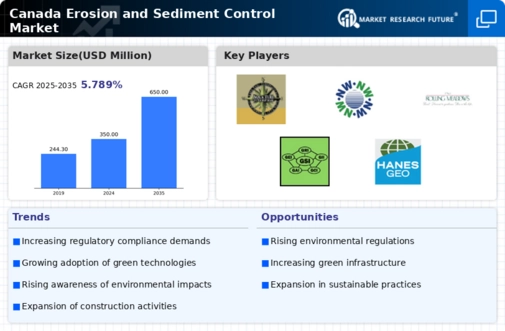Rising Environmental Awareness
The erosion and-sediment-control market in Canada is experiencing growth due to increasing environmental awareness among the public and businesses. As citizens become more informed about the impacts of erosion on ecosystems, there is a heightened demand for effective erosion control solutions. This awareness is reflected in the growing number of community initiatives aimed at preserving natural landscapes and waterways. Furthermore, businesses are recognizing the importance of sustainable practices, leading to investments in erosion control technologies. According to recent data, the market is projected to grow at a CAGR of approximately 5.2% over the next five years, driven by this shift in public consciousness. The erosion and-sediment-control market is thus positioned to benefit from this trend, as stakeholders seek to mitigate environmental degradation.
Regulatory Compliance Requirements
Regulatory compliance requirements are a critical driver for the erosion and-sediment-control market in Canada. Various federal and provincial regulations mandate the implementation of erosion control measures to protect water quality and prevent soil degradation. The erosion and-sediment-control market must adapt to these evolving regulations, which often require the use of specific technologies and practices. For example, the Canadian Environmental Protection Act emphasizes the need for effective sediment control during construction activities. As compliance becomes increasingly stringent, companies are compelled to invest in advanced erosion control solutions, thereby propelling market growth. The financial implications of non-compliance can be substantial, further incentivizing adherence to regulations.
Climate Change Adaptation Strategies
The erosion and-sediment-control market is being shaped by the necessity for climate change adaptation strategies in Canada. As extreme weather events become more frequent, the risk of soil erosion and sedimentation increases, prompting governments and organizations to implement proactive measures. The erosion and-sediment-control market is likely to see a surge in demand for innovative solutions that address these challenges. For instance, the adoption of green infrastructure, such as bioswales and rain gardens, is gaining traction as effective methods to manage stormwater and reduce erosion. This shift towards adaptive strategies is expected to drive market growth, with estimates suggesting a potential increase in market size by 7% over the next five years.
Infrastructure Development Initiatives
Infrastructure development initiatives across Canada are significantly influencing the erosion and-sediment-control market. With ongoing investments in transportation, urban development, and public works, there is an increasing need for effective erosion control measures to protect construction sites and surrounding environments. The Canadian government has allocated substantial funding for infrastructure projects, which is expected to reach approximately $180 billion over the next decade. This investment creates opportunities for the erosion and-sediment-control market, as contractors and developers seek compliant solutions to manage sediment runoff and erosion during construction activities. The integration of erosion control measures into project planning is becoming a standard practice, further driving market growth.
Technological Innovations in Erosion Control
Technological innovations are playing a pivotal role in shaping the erosion and-sediment-control market in Canada. The development of advanced materials and techniques, such as geotextiles and erosion control blankets, is enhancing the effectiveness of erosion management strategies. These innovations not only improve the performance of erosion control measures but also reduce long-term maintenance costs. The erosion and-sediment-control market is witnessing a trend towards the integration of smart technologies, such as remote sensing and data analytics, to monitor erosion and sedimentation in real-time. This technological evolution is expected to drive market growth, with projections indicating a potential increase in market value by 6% over the next five years.
















Leave a Comment